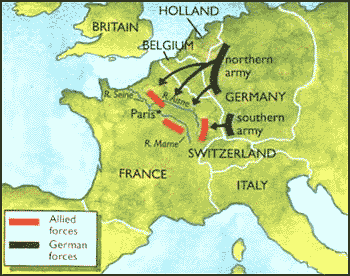The Battle of Mons was the first clash between the land forces of Britain and Germany during World War I.
Following the Belgian defeat at Liege on August 16, 1914, German forces continued their westward push toward France, with Paris as their ultimate objective.
 Previously, on August 14, the British Expeditionary Force (BEF) of 70,000 men had arrived on the continent and begun to move south in an effort to link up with a major French army. The BEF forces under Commander-in-Chief Sir John French proceeded cautiously; they encountered German patrols in southwestern Belgium on August 22. French ignored intelligence warnings about the size of German forces in the area (later learned to be 150,000 men) and began preparations for an attack. During the night, however, French changed his plans and ordered his army to take up defensive positions around the city of Mons, southwest of Brussels and close to the French border.
Early on August 23, German general Alexander von Kluck initiated a frontal assault against the BEF positions. The British defenders included many expert riflemen who extracted an extremely heavy toll among the advancing enemy. German leaders incorrectly concluded that only the use of machine guns could have accounted for their losses.
Later in the day, the arrival of reinforcements and superior artillery firepower turned the tide of battle. British commanders received word of the pullback of neighboring Belgian and French forces and followed suit. Initially, German soldiers tended their wounded, rather than pursue their retreating opponents. Several days later, the armies engaged again at Le Cateau in northeastern France (August 26); British forces were pushed back with heavy losses.
British War Minister Lord Kitchener then ordered the BEF to pull back to the banks of the River Marne outside of Paris.
Previously, on August 14, the British Expeditionary Force (BEF) of 70,000 men had arrived on the continent and begun to move south in an effort to link up with a major French army. The BEF forces under Commander-in-Chief Sir John French proceeded cautiously; they encountered German patrols in southwestern Belgium on August 22. French ignored intelligence warnings about the size of German forces in the area (later learned to be 150,000 men) and began preparations for an attack. During the night, however, French changed his plans and ordered his army to take up defensive positions around the city of Mons, southwest of Brussels and close to the French border.
Early on August 23, German general Alexander von Kluck initiated a frontal assault against the BEF positions. The British defenders included many expert riflemen who extracted an extremely heavy toll among the advancing enemy. German leaders incorrectly concluded that only the use of machine guns could have accounted for their losses.
Later in the day, the arrival of reinforcements and superior artillery firepower turned the tide of battle. British commanders received word of the pullback of neighboring Belgian and French forces and followed suit. Initially, German soldiers tended their wounded, rather than pursue their retreating opponents. Several days later, the armies engaged again at Le Cateau in northeastern France (August 26); British forces were pushed back with heavy losses.
British War Minister Lord Kitchener then ordered the BEF to pull back to the banks of the River Marne outside of Paris.